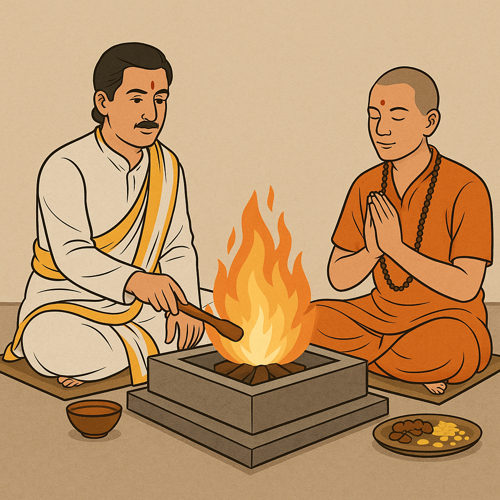In the vast expanse of Hinduism, the temple (mandir) stands not merely as a structure of stone and art, but as a sacred space where the divine and the devotee converge. While it's true that the Supreme resides in all beings and places, temples serve as focal points for spiritual practices, offering a conducive environment for worship, reflection, and community gatherings.
Temples are meticulously designed following ancient architectural principles, such as Vastu Shastra, to harness and amplify spiritual energies. The sanctum sanctorum (garbhagriha), where the deity resides, is considered the epicentre of these energies, facilitating a deeper connection between the worshipper and the divine.
Beyond spiritual significance, temple visits offer psychological solace, cultural enrichment, and even health benefits. The rhythmic chants, the aroma of incense, and the rituals performed engage the senses, fostering a state of inner peace and balance.
In this article, we will delve into:
The spiritual significance of visiting temples
The role of temples in Hinduism
The benefits, spiritual, psychological, and scientific, of temple visits
The cultural and social importance of temples
Addressing common questions about temple practices
Let us explore how these sacred spaces continue to inspire and guide devotees on their spiritual journey.
Spiritual Significance of Visiting Temples
In Hinduism, temples (mandirs) are not merely architectural structures but are considered sacred spaces where the divine and the devotee converge. They serve as conduits for spiritual energy, facilitating a deeper connection between the individual and the Supreme Consciousness.
- Manifestation of the Divine
Hindu philosophy acknowledges both the Nirguna Brahman (formless, attribute-less Absolute) and the Saguna Brahman (the Absolute with attributes). Temples embody the Saguna aspect, providing tangible forms, murtis, through which devotees can focus their worship and devotion. This tangible representation aids in cultivating a personal relationship with the divine.
- Centers of Spiritual Energy
Temples are meticulously constructed following ancient architectural principles, such as Vastu Shastra, to harness and amplify spiritual energies. The sanctum sanctorum (garbhagriha), where the deity resides, is considered the epicentre of these energies. The placement of idols, often after rituals like Prana Pratishtha (infusion of life force), ensures that the space becomes a vibrant centre of spiritual energy. Devotees believe that by entering the temple and engaging in rituals, they can absorb these positive vibrations, leading to inner purification and spiritual upliftment.
- Facilitating Inner Transformation
Regular visits to temples encourage discipline, humility, and devotion. Engaging in rituals, listening to chants, and participating in communal prayers foster a sense of unity and collective consciousness. This environment supports individuals in transcending egoistic tendencies, promoting inner peace and spiritual growth.
- Sacred Rituals and Practices
Temples offer a structured environment for performing various rituals that are integral to Hindu worship. These include Abhishekam (ritual bathing of the deity), Aarti (waving of lighted lamps), and Pradakshina (circumambulation). Such practices are designed to engage the senses and focus the mind, facilitating a deeper meditative state and reinforcing the devotee's connection to the divine.
In essence, visiting temples serves as a means to align oneself with higher spiritual frequencies, offering a sanctuary for introspection, devotion, and communion with the divine.
The Role of Temples in Hinduism
Temples are not simply places of prayer; they are pillars of the Hindu way of life. In a tradition that honours both the formless and the form, temples act as sacred anchors for individuals, families, and communities to stay rooted in Dharma (righteous living), Bhakti (devotion), and Samskara (spiritual refinement).
- Dwelling Place of the Divine
In Hindu belief, once a deity is consecrated through Prana Pratishtha, the murti (idol) in the temple is not a mere representation, it becomes a living presence of the divine. This makes the temple a direct gateway for darshan, the act of seeing and being seen by the deity, which is believed to cleanse karmas and elevate consciousness.
- A Bridge Between Bhuloka and Devloka
Temples are designed to serve as spiritual batteries, transmitting divine frequencies through mantras, yantras, rituals, and architecture. The garbhagriha (sanctum) is seen as the womb of divine energy. When devotees enter a temple with reverence, they receive that energy and carry it with them into their lives.
- Centers of Dharma and Culture
Traditionally, temples were not only spaces of worship but also hubs of:
Learning (vidya) – including Sanskrit, Vedas, arts, and philosophy
Charity (daan) – food, clothes, and medicine for the poor
Community gatherings – festivals, rituals, and celebrations
Civic responsibility – many temples historically supported local governance and education
Thus, the temple is both a spiritual sanctuary and a social institution.
- Temples as Places of Samskara
From birth to death, temples guide the rites of passage in Hindu life. Namakarana (naming), Annaprashana (first food), Vivaha (marriage), and even Antyeshti (last rites) are often performed with temple blessings, making it central to one's life journey and spiritual evolution.
In Hinduism, the temple is not a passive place of worship. It is an active source of transformation, designed to lift the devotee from the ordinary to the divine.
Benefits of Going to Temple
While temples hold immense spiritual value, their influence also extends to the mind, emotions, energy system, and even community well-being. The atmosphere of a temple is carefully created to purify the inner and outer self, engaging all senses and drawing the mind inward.
Psychological and Energetic Benefits
- Mental Stillness and Clarity
Temples are designed to foster introspection and surrender. The quietness, rhythmic chanting, and sacred rituals naturally reduce mental clutter. The mind shifts from its habitual noise to a space of stillness and receptivity.
- Emotional Grounding
Temple rituals, such as darshan, aarti, and pradakshina, offer predictable, rhythmic patterns. This has a calming effect on the nervous system. Regular visits help individuals:
- Reduce anxiety and restlessness
- Cultivate patience and gratitude
- Feel emotionally supported by the divine presence
- Chakra Alignment and Energy Rebalancing
Temples are built over energy centers (ksetras) and are designed to awaken the subtle body:
- Pradakshina (circumambulation) harmonizes the etheric flow around the body
- The sound vibrations of mantras and bells stimulate the Ajna and Sahasrara chakras
- The presence of aroma (dhoop, camphor) clears negative energy fields
- Being in a temple is like recharging your subtle energy body.
- Bhakti Transforms Ego
Temple worship breaks the mind’s patterns of “me and mine.” Folding hands, bowing down, touching the feet of the deity, all these gestures humble the ego, invoking surrender. Bhakti (devotion) softens emotional blockages and promotes spiritual openness.
- Community Support and Upliftment
Temples are not just for individual worship. They are containers of shared devotion. Seeing others pray, chant, or silently cry reminds you that you are not alone on your spiritual journey. This fosters compassion, connection, and service-mindedness.
A temple is not just a building. It is a living field of sacred resonance, crafted to awaken the divine within.
Scientific and Ayurvedic Viewpoints
While temples are revered for their spiritual significance, they also offer tangible benefits that align with scientific principles and Ayurvedic wisdom. These benefits encompass architectural design, sensory engagement, and holistic well-being.
- Architectural Design and Energy Flow
Temples are meticulously constructed following ancient architectural principles, such as Vastu Shastra, to harness and amplify spiritual energies. The sanctum sanctorum (garbhagriha), where the deity resides, is considered the epicentre of these energies. The placement of idols, often after rituals like Prana Pratishtha (infusion of life force), ensures that the space becomes a vibrant centre of spiritual energy. Devotees believe that by entering the temple and engaging in rituals, they can absorb these positive vibrations, leading to inner purification and spiritual upliftment.
- Sensory Engagement and Neurological Impact
Temple rituals engage all five senses, which can have a calming effect on the nervous system:
Hearing:
The ringing of bells produces sound frequencies that can help focus the mind and create a sense of tranquillity.
Sight:
The sight of the deity and the flickering of oil lamps can induce a meditative state.
Smell:
The aroma of incense and flowers can have a soothing effect on the mind.
Touch:
The act of prostration and touching the temple floor can ground the body and mind.
Taste:
Consuming prasadam (sanctified food) can create a sense of community and spiritual fulfilment.
These sensory experiences can activate the parasympathetic nervous system, promote relaxation and reduce stress.
- Ayurvedic Perspectives on Temple Visits
Ayurveda, the ancient Indian system of medicine, emphasizes the balance of the three doshas: Vata, Pitta, and Kapha. Temple visits can contribute to this balance in several ways:
Grounding Vata:
Walking barefoot in the temple premises can help ground the Vata dosha, which is associated with movement and instability.
Cooling Pitta:
The serene environment and rituals can pacify the Pitta dosha, linked to heat and intensity.
Stimulating Kapha:
Engaging in devotional singing and movement during rituals can invigorate the Kapha dosha, associated with inertia.
Furthermore, the consumption of Thirtham (holy water) and prasadam can aid in digestion and overall well-being.
In essence, temple visits offer a holistic experience that nurtures the body, mind, and spirit, aligning with both scientific understanding and Ayurvedic principles.
Cultural and Social Importance
Temples in Hinduism are not only spiritual sanctuaries, they are also cultural keystones. For centuries, they have served as spaces that nurture art, learning, community bonding, and ethical living. Even today, in both rural and urban India, temples continue to hold a central place in social life.
- Hubs of Cultural Preservation
Many of India’s classical art forms, such as Bharatanatyam, Odissi, Carnatic music, and temple sculpture, originated in temple settings. The architecture, murals, and inscriptions inside temples preserve regional languages, epics, folklore, and Vedic traditions.
Temple festivals (utsavs) include:
- Traditional music and dance performances
- Recitations of Ramayana, Mahabharata, or Puranas
- Storytelling, processions, and rituals that keep oral and visual culture alive
- Building Community Identity
Temples are the heart of many towns and villages. They act as:
- Gathering spaces during festivals, fasts, and holy days
- Platforms for collective rituals like group pujas, annadan (food donations), and homams
- Spiritual schools, offering Veda pathashalas or classes on dharma, yoga, and ethics
- This shared rhythm of temple-centred life helps preserve moral values, intergenerational wisdom, and social harmony.
- Spiritual Equality and Social Inclusion
In many temples, especially during large festivals and annadans. Everyone sits and eats together, irrespective of caste, class, or status. This tradition reinforces the ideal that in front of the divine, all are equal.
While history includes challenges with exclusivity, today many temples are actively embracing inclusiveness, focusing on seva (service) and spiritual unity.
- Crisis and Healing Spaces
Temples have often served as refuges in times of personal or collective difficulty. People go to pray for health, to grieve, to seek hope. In rural India, temples are sometimes even consulted during agricultural or ecological decisions, reminding society of its interconnectedness with nature and dharma.
The temple is not just a place of personal salvation; it is the soul of collective memory and sacred belonging.
Daily vs Occasional Temple Visits
In the path of Sanatan Dharma, how often you visit a temple is less important than the inner state with which you visit it. Whether one goes every day or only during festivals, the purpose is the same, to come closer to the divine, to pause the restless mind, and to remember one’s higher self.
Each pattern of temple attendance carries its own energy:
Daily visits weave the divine into one’s routine
Occasional visits are often more focused, symbolic, or emotionally charged
What truly sanctifies the visit is not the calendar. It is the intention, presence, and humility with which the soul arrives at the doorstep of the Divine.
- The Value of Daily Temple Visits
Strengthens spiritual routine:
Visiting the temple daily creates a sacred rhythm in one’s life. It begins or ends the day with gratitude, prayer, and inner quietude.
Purifies the mind:
Daily darshan helps gradually remove negative thoughts and align one’s focus toward the divine.
Connects one with sattvic energy:
Being in a spiritually charged environment daily has subtle effects on one’s aura, thoughts, and karmic field.
Encourages humility:
Bowing daily, offering flowers or prayers keeps the ego in check and cultivates inner discipline.
Many saints and seekers emphasize that just standing silently in a temple daily can do more than hours of distracted sadhana at home.
- The Purpose of Occasional Visits
Festivals, pujas, and vrats:
For many, temples are visited during auspicious days, holy fasts, or personal milestones, such as birthdays, marriages, or new ventures.
Emotional and spiritual need:
People may go occasionally when facing challenges—seeking clarity, peace, or healing.
Special darshans and abhishekams:
Occasional visits are often marked with deeper reverence because the devotee comes with clear intent, longing, or sankalpa.
Even an occasional visit, when done with shraddha (faith) and ekagrata (focused mind), can uplift the heart and energize the soul.
- What Matters Most: Bhava Over Frequency
In the Bhagavad Gita, Lord Krishna does not demand daily offerings. He asks for sincerity:
“Patram pushpam phalam toyam yo me bhaktya prayacchati…”
(Gita 9.26)
“Whoever offers Me with devotion a leaf, a flower, a fruit, or water. I accept that offering of love.”
Whether you visit the temple daily, weekly, or only when your soul calls you, let the heart be fully present, that alone sanctifies the journey.
Are Temples Necessary for Spirituality?
This is a question many modern seekers ask:
If God is everywhere, why go to a temple at all?
The answer lies not in theology, but in experience. While divinity is indeed all-pervading, a temple is a concentrated field of sacred intention, designed to help us shift from the distractions of the world to the stillness of the soul.
- God Is Everywhere, but Are We Aware?
Hindu philosophy accepts that Ishwara resides in every being, every breath, and every atom. But the human mind, wrapped in desires and duties, often forgets this. A temple serves as a reminder. A space where the sacred is not abstract but felt.
- A Temple Helps the Seeker, Not the Divine
Just as a mirror helps you see your reflection more clearly, a temple helps you see your inner self more deeply. The structure, the chants, the murti, the prasad—these are not for God’s benefit, but for ours. They align the senses, purify the energy, and open the heart.
Temples are not about locating God. They are about locating yourself in the presence of the Divine.
- Inner and Outer Shrines Must Meet
The Bhagavad Gita speaks of the inner journey, meditation, discipline, and detachment. Yet, even Lord Krishna encouraged yajna (sacrifice), seva (service), and bhakti (devotion). Visiting temples doesn’t negate internal practice. It supports and grounds it.
Just as fire burns more brightly when offered air, the soul burns more purely when surrounded by sacred architecture and community energy.
- Can You Be Spiritual Without Visiting Temples?
Yes. Many enlightened souls have attained realization through inner discipline alone. Temples are not a rule, but a resource. They are for those who seek support, direction, purification, and satsang on the journey.


-in-Astrology.jpg)






.jpg)



Comments 0
Leave your thought here